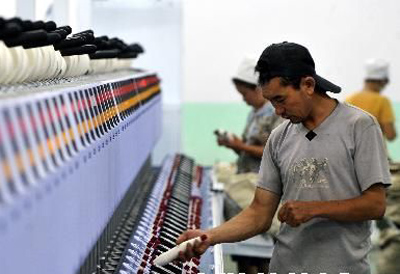April 11, 2020
Improve the Cotton Textile Industry Taxation Policy to Improve the Competitiveness of Domestic Cotton Textile Industry
 I. Pilot cotton cultivation Direct subsidies policy Accelerated research and piloted the implementation of the direct subsidy policy for cotton cultivation, and improved the current mechanism for determining the temporary purchase and storage prices. While increasing the direct income of farmers, the market played a regulatory role for domestic cotton prices and encouraged cotton farmers to plant High-quality cotton improves cotton quality and creates a good market environment for the development of textile enterprises.
I. Pilot cotton cultivation Direct subsidies policy Accelerated research and piloted the implementation of the direct subsidy policy for cotton cultivation, and improved the current mechanism for determining the temporary purchase and storage prices. While increasing the direct income of farmers, the market played a regulatory role for domestic cotton prices and encouraged cotton farmers to plant High-quality cotton improves cotton quality and creates a good market environment for the development of textile enterprises. Second, increase the support for mechanized planting and reduce cotton production costs Compared with the main food crops, the degree of mechanization of cotton cultivation is low, and the amount of artificial inputs is large. With the rapid increase in labor costs in recent years, the large-scale artificial investment in cotton cultivation has become a major factor restricting China's cotton production. Therefore, the state should increase its support for home-made cotton pickers, raise the subsidy standard for domestic cotton picker manufacturers, increase the R&D input of domestic cotton pickers, and increase the mechanization of cotton cultivation to ease the rapid increase in cotton planting costs. pressure.
Third, to improve the current temporary purchase and storage price determination mechanism The State is advised to strengthen the cotton market, actively explore the cotton purchase and storage prices and international and domestic prices associated with the formation of the mechanism; innovative storage and storage methods, and constantly improve the "business + base + Under the current mode of temporary purchase and storage, the “farmer households†model of agricultural industrialization can explore the form of direct acquisition, shareholding, or commissioned processing by the China Reserve Cotton Management Corporation, and cooperate with processing companies to reduce the number of temporary purchase and storage transactions. In the middle stage, the benefits of the temporary collection and storage policy were effectively implemented in the hands of cotton farmers.
Fourth, adjust the current cotton import quota management policy to improve the cotton import quota management mechanism, change from time to time to issue quotas for a one-time annual payment. As soon as possible, the total amount of annual quotas will be announced to stabilize the market expectations of cotton farmers and cotton spinning companies. The quota application and issuance procedures are completely open and transparent. The import quota for cotton is cut according to the scale of spinning spindles in each province and district, and is distributed by provinces and districts. From the perspective of medium and long-term development, it is proposed to comprehensively reform the domestic cotton import management system, and on the basis of appropriately increasing subsidies for cotton cultivation and safeguarding the interests of cotton farmers, the import quotas and sliding tariff management will be completely eliminated, and the marketization of cotton prices at home and abroad will be realized.
V. Resolving the problem of "high-returning and low-bucking" of value-added tax for textile enterprises, and effectively reducing the burden on enterprises
Suzhou Makeit Technology Co., Ltd , https://www.psffiber.com